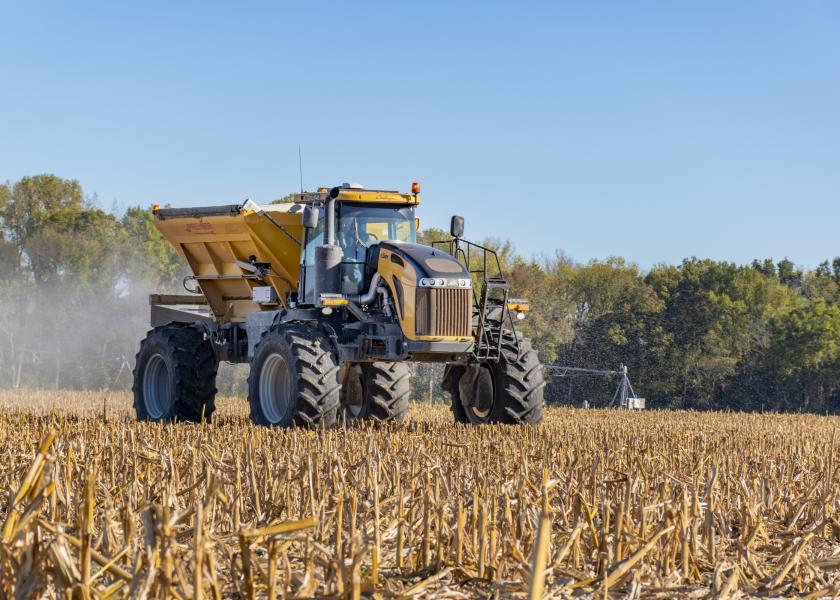USDA Is Now Sending Out $500 Million to Fight High Fertilizer Prices in the U.S.

USDA unveiled additional plans to help boost domestic fertilizer production including $500 million in grants. In an announcement Monday, the plan aims to bring more of the critical input sourcing stateside, and therefore reduce the risk of a series of black swans that have flown into the fertilizer market in the past two years.
Farmers are currently looking at fertilizer prices that are trending higher for fall, aiding economic concerns and anxiety about potential farm income for 2023. However, some in the fertilizer industry warn adding fertilizer production in the U.S. will take time and could ultimately lead to higher fertilizer costs.
Tuesday's announcement marks the second time for USDA to unveil a plan on this issue this year. In March, USDA announced plans to make $250 million available toward pushing more American-made fertilizer. At the time, USDA said it intended to use funds from the Commodity Credit Corporation (CCC) to develop a grant program to provide ‘gap’ financing to bring new, independent domestic production capacity on-line.
Details of USDA's Fertilizer Production Expansion Program
Six months later, that plan is now coming to fruition. On Tuesday, USDA announced details around what it's calling the Fertilizer Production Expansion Program, saying the funding is double what the agency originally set aside with $500 million now available in grants.
“Under the leadership of President Biden and Vice President Harris, USDA is creating a resilient, secure and sustainable economy, and this support to provide domestic, independent choices for fertilizer supplies is part of that effort,” says U.S. Agriculture Secretary Tom Vilsack. “USDA believes in the growth of innovative, local businesses owned and shared by people who can best serve their own unique community’s needs, fill gaps, and build opportunities. Recent supply chain disruptions have shown just how critical it is to invest in the agricultural supply chain here at home. The Fertilizer Production Expansion Program is one example of many Biden-Harris Administration initiatives to bring production and jobs back to the United States, promote competition and support American goods and services.”
The Biden administration says the grants are geared toward independent producers who are working toward sustainable American fertilizer production for farmers.
- The maximum grant amount is $100 million
- Thee minimum is $1 million.
- Each grant term is five years.
The White House says the funds can be used to help expand manufacturing of fertilizer as well as alternatives, through:
- Independent, and outside the orbit of dominant fertilizer suppliers. Because the program’s goal is to increase competition, market share restrictions apply.
- Made in America. Products must be produced by companies operating in the U.S. or its territories, to create good-paying jobs at home, and reduce the reliance on potentially unstable, inconsistent foreign supplies.
- Innovative. Techniques will improve fertilizer production methods and efficient-use technologies to jumpstart the next generation of fertilizers and nutrient alternatives.
- Sustainable. Ideally, products will reduce the greenhouse gas impact of transportation, production and use through renewable energy sources, feedstocks and formulations, incentivizing greater precision in fertilizer use.
- Farmer-focused. Like other Commodity Credit Corporation investments, a driving factor is providing support and opportunities for U.S. agricultural commodity producers.
The Fertilizer Institute President and CEO Corey Rosenbusch said: “The U.S. fertilizer industry consists of large international corporations, small regional producers, and everything in between. They all play a critical role in suppling farmers with the nutrients required to grow the food that feeds the world. While a nitrogen plant can cost between $2-$4 billion to construct, anything that helps strengthen domestic fertilizer production is a win for the industry, growers, and consumers.”
What's Causing High Fertilizer Prices Today?
The U.S. currently ranks in the top three for fertilizer imports. Most of those products, or components of fertilizer, come from countries including China, Russia, Canada and Morocco. Supply chain issues led to soaring fertilizer prices last fall. Those prices crept even higher ahead of spring planting this year. It wasn’t just price that was a concern, but also availability of fertilizer.
A year ago, news that about black swans hitting the fertilizer industry was a trending story. From the impacts of Hurricane Ida to political and climate issues entangled in a cobweb of production slowdowns in Europe and China, the Black Swan events continued to stack up.
A year later, the issues are still prevalent as farmers face rising fertilizer prices again. From corn prices, transportation issues to even energy prices, there are several factors driving the resurgence of fertilizer prices leading into fall.
Nitrogen prices averted a major disaster two weeks ago when rail companies and rail unions reached a tentative agreement and avoided a possible strike. Even with the positive news, this chart from StoneX Group shows prices are climbing back toward the highs producers saw last spring.
Concerns About Farm Income in 2023
USDA Chief economist Seth Meyer spoke at the Ag Outlook Forum in Kansas City this week. He described the financial outlook for farmers in 2023 as one that comes with more anxiety, and the main reason is over concerns commodity prices won’t rise at the same rate as input prices. One of those pricey inputs causing concern is the increasing price of fertilizer.
“I think for U.S. producers, it's all going to be about price,” Meyer told AgWeb. “You'll be able to get what you want, but it's going to be about price. I's not going to be at the price you want to pay. I think that part of what we're seeing on costs for this crop that folks are harvesting now was some folks bought ahead and didn't face the full brunt of those rising fertilizer prices.”
Meyer says he doesn’t see fertilizer prices trending back down toward pre-pandemic levels in the short-run.
How High Are Fertilizer Prices Today?
Just how high are nitrogen prices today? One ag retailer in Missouri told AgWeb anhydrous prices for falls needs were:
- $800 per ton during the fall of 2021
- $1500 during the spring of 2022
- Farmers booking fall anhydrous today are paying $1325
A retailer located in Iowa also reported a fertilizer price increase this fall. The location reported:
- Prices started around $700 during the fall of 2021 and jumped to $1500 by the end of last fall
- Prices jumped to $1,700 during the spring of 2022
- Farmers looking to book for fall of 2022 saw prices that started at $1000 per ton, but now it's more than $1400 per ton
“Historically we might have thought fertilizer is primarily an energy cost input,” says Brad Lubben, agricultural economist with the University of Nebraska-Lincoln. “Energy drives the cost of fertilizer, but so does output so does the price of corn. So do the supply shocks overseas in terms of foreign suppliers. So do the current energy shocks in Europe, which leaves all kinds of questions about the winter natural gas supply and availability, as well as transportation and everything else that we see going on here with the challenges we’re seeing today. Volatility is something producers are going to have to manage."
Can the Push to Domesticate Fertilizer Production Solve the Issues?
While the short-term price issues are causing concern for farmers today, economists also say moving production domestically will take time. The reason fertilizer production moved to countries like China, Russia and others was due to a lower cost of energy, as well as not as many regulatory hurdles to jump through.
As the Biden administration works toward adding fertilizer capacity in the future, there will be 45-day application window for applicants to receive priority for projects that increase the availability of fertilizer (nitrogen, phosphate or potash) and nutrient alternatives for agricultural producers to use in crop years 2023 or 2024. An additional 45 days will be available for an extended application window to receive applications for financial assistance.







